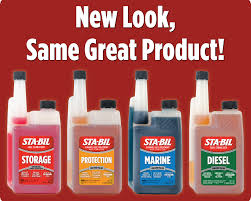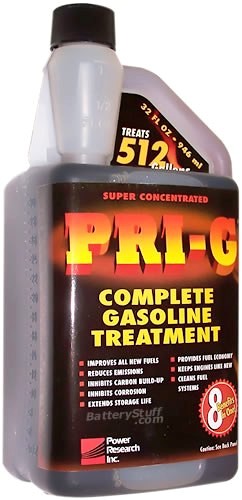Since we have been on the subject of mothballing and maintaining small engines. I decided that now was a good time to talk about fuel stabilizers. Yesterday I started a mothballed motor that had been in storage for several years without any major problems. However, I am sure that somewhere somebody is having a problem with their motor and old fuels.
If you use fuel stabilizers in your stored fuels on a routine basis, you will greatly reduce your changes of a problem. What has happened to me in the past is that I buy some fuel with the intentions of using it right away. But it gets partly used and the rest is forgotten. So now, I use fuel stabilizers all the time.
I have been noticing that with the new gas it seems to be more of a problem than in the past. My old policy was to rotate the gasoline every 6 months unless I added a fuel stabilizer like Sta Bil or PRI-G. Now I add a stabilizer to all fuels
Be aware that both Sta Bil and PRI-G have a shelf life of their own and cannot be kept indefinitely. PRI-G claims an indefinite shelf life in new sealed containers, but this drops to three years once opened.

Sta Bil is a bit different. Their website states the following. “The shelf life of all STA-BIL® brand products is 2 years after the bottle has been opened, provided it has been tightly capped and stored in a cool, dry place. If the product has not yet been opened, you should use the color of the fluid as an indicator. If the product is still bright red, it is fine to use. If the product has turned to a very dark red (or brown) color, we recommend purchasing a new bottle. It will not harm anything if you use an old bottle of STA-BIL® brand, it just may not be as effective”.
PRI-G unlike Sta Bil will restore old gasoline. The company claims it has worked on gasoline as old as 13 years. I normally use PRI-G for gasoline and PRI-D for diesel.
I have converted my Honda Generators to operate on tri fuel, gasoline, propane and natural gas. This is an easy conversion to make. Here is a link to a post on Tri Fuel Generator Conversions.
If you are running propane, it eliminates most of the problems of mothballing small engines.
Howard



Stabil deteriorates eventually over time sitting unopened on a shelf in the garage. The idea of fuel “stabilizer” being unstable doesn’t sit right, so I switched to SeaFoam years ago and never looked back. Seafoam works well in cleaning carbon from engines and varnish from carbs. I used it as a stabilizer in outboards sitting for six months over a New Hampshire winter and the fuel was always fine in spring.
I doubt that non-ethanol automotive motor fuel stored in an air tight containers over a winter in cold temperatures breaks down much. My buddy in Alaska with the Army Corps of Engineers says they do most construction work during the winter, over ice roads pushed through the bush to access northern native communities. They bring in supplies of diesel, avgas and automotive fuel to last the villages all year. Bush pilots fly up to north slope oil fields during summer and arrange to have Beaver float planes to cache 45 gallon drums of that AvGas and JP8 at designated cache points along the designated flight paths. That fuel often isn’t used for up to seven or more months. I don’t know if the fuel is pre-stabilized before being loaded into drums or if it doesn’t need it. Experienced bush pilots have flown throughout Canada and Alaska for over 50 years and so far as I’ve been told fuel quality/contamination was never claimed to be an issue, but pilots still carry a chamois, hand drum pump and a funnel!
Automotive fuel blended with ethanol is a different breed of cat! Before E-10 came along I never had any issues storing 5 gal Jerricans of unstabilized “regular gas.” Now with unleaded E-10 you must use it within 90-120 days or store stabilized gas unless you tear the carb apart in the Spring. DO NOT use ethanol blended gas in two-stroke engines or in small engines such as portable generators. Troublesome and expensive engine repairs may become necessary.
Check this out:
https://www.fuel-testers.com/is_gas_additive_safe_with_e10_list.html
StaBil and Star Tron are the only recommended ones !
Other information from that same website makes a good case for NOT storing E-10 fuel, but to seek out non-ethanol fuel if the fuel will not be used within a year, when stabilized. Industry sources claim shelf life of E-10 is not different from non-ethanol fuel, but all recommend adding stabilizer if kept more than 90 days. The fact that Stabil is one of the only suitable stabilizers for E-10, but that Stabil can go bad unopened merely sitting on the shelf in long term storage makes E-10 impractical in my view. See:
https://www.fuel-testers.com/expiration_of_ethanol_gas.html
Ethanol and gasoline are miscible. If excessive moisture is introduced to the ethanol/gasoline fuel mixture, the ethanol and water phase separates (falls out of suspension) from the fuel, which
results in a mixture of ethanol and water in the bottom of the fuel tank. Aside from the fact that the engine will not operate on this ethanol/ water blend, it causes corrosion of the various metals with which it comes in contact. Preventing corrosion requires proper maintenance and storage, including checking for water contamination of fuel tanks and removal of water before re-fueling. E10 absorbs moisture from the air, so it is vitally important to have tight fitting caps on fuel tanks and storage containers.
Both gasoline and E10 fuel blends oxidize and deteriorate in storage
leading to gummy deposits in the fuel system. Old gasoline causes hard starting due to loss of volatile components of the fuel from evaporation. Very warm storage temperatures accelerate this type of fuel deterioration. If the gasoline in your fuel tank and carburetor deteriorates during storage, you may need to have the carburetor and other fuel system components serviced or replaced.
https://www.chevron.com/products/prodserv/fuels/bulletin/longterm_gasoline/background-info.shtml